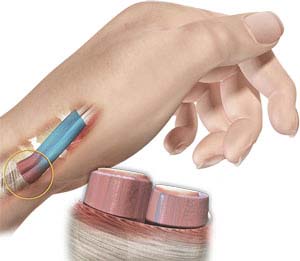
Anatomy of the Tendons of the Hand
The muscles and bones of your hand are connected by thick flexible tissue called tendons. Tendons are covered by a thin film of tissue known as synovium and travel within tendon sheaths. Extensor pollicis brevis and abductor pollicis longus are two tendons located on the thumb side of the wrist.
What is De Quervain’s Tenosynovitis?
Strain on these tendons can cause swelling and irritation, and lead to a condition called De Quervain's tenosynovitis, which is characterized by inflammation. Inflammation and swelling of the tendon sheaths leads to pain in the thumb side of the wrist. The condition is also referred to as De Quervain’s tendinitis or De Quervain’s disease.
Causes of De Quervain’s Tenosynovitis
The exact cause of De Quervain’s tenosynovitis is unknown, but it is usually seen in individuals with repetitive hand or wrist movements, injury to the wrist or tendons, and inflammatory conditions such as arthritis. De Quervain’s tenosynovitis is most common in pregnant and middle-aged women.
Signs and Symptoms of De Quervains Tenosynovitis
The symptoms of De Quervain's tenosynovitis include pain and tenderness on the side of the wrist at the base of your thumb. You may also have a little swelling and redness in the area. Your symptoms may get worse while making a fist, grasping or gripping objects, or turning the wrist. You may experience a "catching" or "snapping" sensation while moving your thumb.
Diagnosis of De Quervains Tenosynovitis
Your physician diagnoses De Quervains tenosynovitis by observing your symptoms, medical history and performing a physical examination of the wrist. De Quervain’s tenosynovitis can be confirmed through the Finkelstein test. For this test, your doctor will ask you to make a fist with your fingers covering the thumb and bend the wrist towards your little finger. Pain during this movement will confirm the condition.
Treatment for De Quervains Tenosynovitis
The treatment of De Quervain’s syndrome consists of both non-surgical and surgical therapy.
Non-surgical therapy includes avoiding activities that increase pain and swelling, applying ice, using a splint to support and immobilize the wrist and thumb, and physical therapy. Anti-inflammatory drugs are helpful in relieving pain and swelling. Your physician may also recommend a corticosteroid injection to reduce the swelling of the tendon sheath.
Your physician will recommend surgery based on the severity of your symptoms and response to non-surgical treatment methods. The outpatient surgical procedure involves opening or cutting the inflamed region of the tendon sheath to relieve the pressure on the tendon and allow free movement of the wrist.
Postoperative Care following Surgery for De Quervains Tendinosis
After the surgical procedure, a wrist splint may be used while your soft tissues recover. Your surgeon will also instruct you on exercises to strengthen your wrist.
Related Topics
- Wrist Fracture
- Fractures of the Hand and Fingers
- Wrist Sprain
- Flexor Tendon Injuries
- Distal Radioulnar Joint (DRUJ) Arthritis
- Ulnar Nerve Compression in Guyon's Canal
- Scaphoid Facture
- Industrial Hand Trauma
- Distal Radius Osteotomy to Correct Mal-Union (Crooked Painful Wrist)
- Distal Intersection Syndrome
- Distal Biceps Avulsion
- Adult Forearm Fractures
- Arthritis of the Hand and Wrist
- Arthritis of the Thumb
- Ganglion Cyst
- Boutonniere Deformity
- Carpal Tunnel Syndrome
- De Quervain's Tendinosis
- Dupuytren's Contracture
- Hand Pain
- Hand Infections
- Trapeziometacarpal (TMC) Arthritis
- Wrist Injuries
- Wrist Tumors
- Boxer's Fracture
- Swan Neck Deformity
- Carpal Instability
- Bennett's Fracture
- Kienbock's Disease
- Scapholunate Dissociation
- Triscaphoid Joint Arthritis
- Ulnar Carpal Impaction
- Triangular Fibrocartilage Complex Injury (TFCC)
- Guyon's Canal Syndrome
- Hand Masses
- Distal Radioulnar Joint (DRUJ) Instability
- Work Related Hand Injuries
- Wrist Ligament Tear and Instability
- Metacarpophalangeal Joint Arthritis





